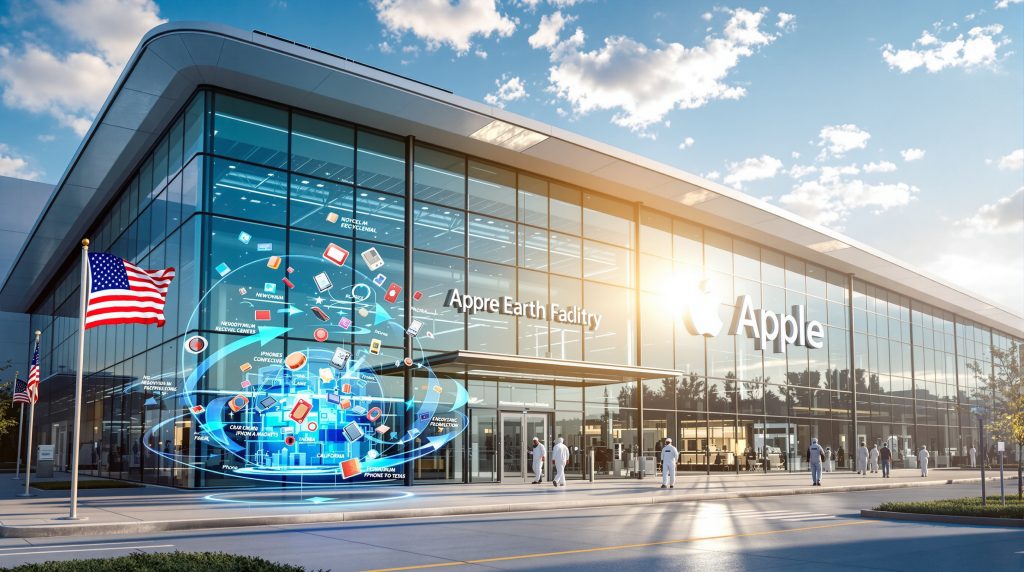Apple's $500 Million Texas Processing Plant: Strategic Investment in Rare Earth Supply Chain
Apple's $500 million investment in a Texas processing facility marks a significant shift in how technology companies are approaching critical mineral supply chains. This strategic move represents more than just a financial commitment—it signals a fundamental change in how tech giants are securing essential materials for their products while addressing environmental and geopolitical concerns.
The Fort Worth facility will focus on processing rare earth elements—critical components in everything from iPhone speakers to electric vehicle motors. By establishing domestic processing capabilities, Apple is taking direct control of a crucial link in its supply chain that has historically been dominated by overseas producers.
Why Are Tech Companies Investing in Mineral Processing?
Growing Concerns About Supply Chain Vulnerability
The technology sector's dependence on rare earth elements has created significant vulnerabilities. These critical minerals energy transition are essential components in smartphones, computers, and other high-tech devices, yet their processing has been heavily concentrated in a few countries, particularly China, which controls approximately 60% of global rare earth mining and 85-90% of processing capacity according to U.S. Geological Survey data.
Recent global supply chain disruptions have highlighted these vulnerabilities. From pandemic-related shipping delays to geopolitical tensions affecting trade routes, tech companies have faced unprecedented challenges in securing reliable access to critical materials. According to McKinsey Global Institute research, supply chain disruptions in 2020-2022 affected 75% of companies worldwide, accelerating the push toward supply chain diversification and domestic processing capabilities.
The Strategic Value of Vertical Integration
By investing directly in processing capabilities, Apple is pursuing a vertical integration strategy that provides several competitive advantages:
- Supply Security: Direct involvement in processing reduces dependence on external suppliers
- Quality Control: Greater oversight of material specifications and performance
- Innovation Opportunities: Closer proximity to material development enables faster product improvements
- Environmental Standards: Direct control allows implementation of stricter sustainability practices
This approach represents a significant departure from traditional tech industry supply chain models, which have typically focused on assembly rather than raw material processing.
What Will Apple's Texas Processing Facility Produce?
Specialized Rare Earth Magnets for Consumer Electronics
The Fort Worth facility will focus primarily on producing neodymium magnets—critical components found in numerous Apple products. These powerful permanent magnets are essential for the performance of speakers, haptic feedback mechanisms, and various sensors in devices like iPhones, AirPods, and MacBooks.
The specialized production lines will be designed specifically for Apple's exacting specifications, ensuring consistent quality and performance across their product ecosystem. This customization capability represents a significant advantage over relying on general-purpose suppliers.
Recycled Material Integration
A cornerstone of the facility's operations will be the integration of recycled rare earth materials. The processing plant will work in conjunction with a complementary recycling facility in California that will:
- Extract rare earth elements from used electronics and industrial scrap
- Process these materials to meet Apple's quality standards
- Supply the Texas facility with recycled inputs for new component production
This closed-loop approach aligns with Apple's broader environmental goals while reducing dependence on newly-mined materials. According to research published in the Journal of Cleaner Production, rare earth recycling can reduce environmental impact by 60-80% compared to primary mining.
When Will the Texas Facility Begin Operations?
Production Timeline and Capacity Expansion
The $500 million investment will fund both construction and operational capabilities, with production expected to commence in 2027. The facility will undergo a phased development approach:
- Initial Construction Phase: Building the core processing infrastructure
- Equipment Installation: Setting up specialized production lines
- Testing and Certification: Ensuring output meets Apple's specifications
- Initial Production: Beginning with smaller production volumes
- Scale-Up: Gradually increasing capacity to meet demand
Once fully operational, the facility is expected to significantly boost domestic rare earth magnet production capacity, though specific output volumes have not been publicly disclosed.
Integration with Existing Supply Networks
The Texas processing plant will not operate in isolation but will be integrated into Apple's broader supply network. This integration includes:
- Coordination with Component Manufacturers: Ensuring magnets meet specifications for various applications
- Logistics Planning: Optimizing transportation and delivery schedules
- Quality Assurance Systems: Implementing consistent testing and verification processes
- Supply Chain Visibility: Creating transparency throughout the material flow
This networked approach maximizes the facility's value within Apple's global manufacturing ecosystem.
How Does This Investment Impact the Rare Earth Market?
Reshaping Industry Dynamics
Apple's direct investment in rare earth processing represents a significant shift in market dynamics. Traditionally, technology companies have remained distant from raw material processing, focusing instead on design and assembly. This move signals a new approach that could influence how other tech giants manage their supply chains.
The investment also creates ripple effects throughout the rare earth market:
- Increased Domestic Processing Capacity: Adding significant new production capabilities within the United States, which currently accounts for less than 5% of global capacity according to USGS data
- Market Validation: Demonstrating commercial viability of domestic rare earth processing
- Competitive Responses: Potentially triggering similar investments from other technology companies
- Price Stabilization: Contributing to more predictable pricing through supply diversification
These effects extend beyond Apple's immediate supply needs, potentially benefiting the broader technology manufacturing sector. The global rare earth market, valued at approximately $8.2 billion in 2023 according to Research and Markets, is likely to see increased investment activity as a result.
Geopolitical Implications
The establishment of domestic rare earth processing capabilities carries significant geopolitical implications:
- Reduced Dependence: Decreasing reliance on foreign processing facilities, particularly important as the U.S. imported 74% of its rare earth compounds from China in 2023
- National Security Benefits: Supporting critical mineral supply chains for defense and other strategic sectors
- Policy Alignment: Complementing government initiatives to secure domestic supply of strategic materials
- International Relations: Potentially influencing trade negotiations and mineral diplomacy
By investing in domestic processing, Apple is positioning itself more favorably within the evolving landscape of global resource politics. Furthermore, a comprehensive rare earth reserves analysis shows the importance of diversifying supply sources beyond current dominant producers.
What Environmental Benefits Will the Facility Provide?
Advancing Circular Economy Principles
The Texas facility represents a significant advancement in applying circular economy principles to high-tech manufacturing. By incorporating recycled materials from the California recycling operation, the processing plant will:
- Reduce Primary Resource Demand: Decreasing the need for newly-mined rare earth elements
- Minimize Waste: Capturing value from materials that might otherwise enter landfills
- Lower Environmental Impact: Reducing the ecological footprint associated with rare earth mining
- Demonstrate Scalability: Showing that recycled materials can meet high-performance standards at commercial scale
These circular economy benefits align with growing consumer and regulatory expectations for more sustainable manufacturing practices.
Carbon Footprint Considerations
While specific details about the facility's energy sources haven't been fully disclosed, Apple's commitment to carbon neutrality suggests the operation will incorporate significant sustainability measures:
- Renewable Energy Integration: Potential use of solar, wind, or other clean energy sources
- Energy Efficiency Design: Implementation of advanced process technologies to minimize energy consumption
- Carbon Offset Programs: Possible complementary investments to balance remaining emissions
- Transportation Optimization: Reduced shipping distances compared to overseas processing
These measures would contribute to Apple's broader environmental goals while potentially establishing new industry benchmarks for sustainable mineral beneficiation insights and processing.
How Does This Fit Into Apple's Broader Supply Chain Strategy?
Part of a Comprehensive Investment Approach
The $500 million Texas facility represents just one component of Apple's broader supply chain strategy. This investment is part of Apple's commitment to invest more than $500 billion in the U.S. economy over a four-year period, spanning multiple sectors and initiatives.
Other elements of this comprehensive approach include:
- Supplier Diversity Programs: Expanding relationships with a wider range of component and material providers, with Apple's supplier diversity spending reaching $18.2 billion with diverse suppliers in 2023
- Manufacturing Reshoring: Increasing domestic production of various components
- Research and Development: Investing in next-generation materials and manufacturing processes
- Workforce Development: Supporting education and training programs for advanced manufacturing skills
Together, these initiatives create a more resilient, innovative, and responsive supply ecosystem.
Creating a Blueprint for Future Materials Security
Apple's approach to rare earth processing could serve as a blueprint for securing other critical materials:
- Replicable Model: The processing facility concept could be adapted for other strategic minerals
- Scalable Approach: The combination of recycling and processing creates a framework that can grow with demand
- Industry Collaboration Potential: Possible expansion to serve broader industry needs beyond Apple's requirements
- Policy Influence: Demonstrating viable approaches that could inform government support programs
This pioneering approach positions Apple as a leader in sustainable and secure supply chain management within the technology sector. In fact, MP Materials and Apple announced a $500 million partnership specifically focused on producing recycled rare earth magnets in the United States.
What Does This Mean for the Technology Industry?
A New Paradigm for Tech Supply Chains
Apple's $500 million processing plant in Texas signals a fundamental shift in how technology companies approach material sourcing and processing. This new paradigm includes:
- Direct Involvement: Tech companies taking active roles in upstream supply chain activities
- Material Security: Prioritizing reliable access to critical minerals as a strategic imperative
- Sustainability Integration: Incorporating environmental considerations into core supply decisions
- Domestic Manufacturing: Recognizing the strategic value of local processing capabilities
Other technology companies will likely evaluate similar approaches as they assess their own supply chain vulnerabilities and opportunities. Tesla has already invested in lithium processing partnerships, and Microsoft has signed long-term agreements for sustainable materials sourcing.
Potential Industry-Wide Impacts
The ripple effects of Apple's investment could extend throughout the technology sector:
- Supplier Expectations: Raising standards for environmental performance and supply security
- Investment Patterns: Redirecting capital toward material processing and recycling infrastructure
- Innovation Focus: Accelerating development of alternative materials and recycling technologies
- Competitive Dynamics: Creating new dimensions of competition beyond traditional product features
These changes could fundamentally reshape how technology products are manufactured and how their supply chains are structured. The ongoing evolution in mining industry innovation will likely accelerate in response.
What Challenges Might the Facility Face?
Technical and Operational Hurdles
Despite Apple's resources and expertise, the Texas processing facility will likely face several significant challenges:
- Process Optimization: Developing efficient methods for processing recycled materials to meet exacting specifications
- Quality Consistency: Maintaining uniform performance characteristics across production runs
- Scaling Challenges: Expanding from initial operations to full production capacity
- Technical Workforce: Recruiting and training specialized personnel for advanced manufacturing roles
Addressing these challenges will require sustained investment and a long-term commitment to operational excellence. Only a handful of companies globally possess full rare earth processing capabilities, making the technical expertise required particularly specialized.
Market and Economic Considerations
The facility will also operate within a complex and evolving market environment:
- Price Volatility: Navigating fluctuations in rare earth material prices, which experienced volatility of 40-60% during 2021-2022
- Competitive Responses: Adapting to potential countermoves from established processing companies
- Regulatory Evolution: Adjusting to changing environmental and trade regulations, with environmental permitting for rare earth facilities typically taking 3-5 years in the U.S.
- Technology Shifts: Accommodating potential changes in material requirements as product designs evolve
Successfully managing these factors will be crucial for the facility's long-term viability and value creation. Additionally, the development of a critical minerals strategic reserve in various countries could impact market dynamics.
Conclusion: A Strategic Investment in Technology's Future
Apple's $500 million commitment to rare earth processing in Texas represents far more than a single facility investment—it signals a fundamental rethinking of how technology companies secure critical materials. By taking direct control of this crucial supply chain link, Apple is addressing multiple strategic priorities simultaneously:
- Reducing vulnerability to supply disruptions
- Advancing environmental sustainability goals
- Supporting domestic manufacturing capabilities
- Creating a more resilient product ecosystem
This approach demonstrates how leading technology companies are evolving beyond their traditional roles to secure their future in an increasingly complex global resource landscape. As the facility progresses toward its 2027 operational target, it will likely serve as a closely watched model for similar investments across the technology sector.
The Texas processing plant represents a significant step in reimagining technology supply chains for greater security, sustainability, and resilience—priorities that will only grow in importance as digital technologies continue to transform global society.
Disclaimer: This article discusses future developments and industry trends. While based on available information, readers should be aware that project timelines, specifications, and outcomes may evolve as more details become available.
Want to Spot the Next Major Mineral Discovery?
Discover why major mining finds like those from De Grey Mining and WA1 Resources can generate substantial returns by exploring Discovery Alert's dedicated discoveries page, where our proprietary Discovery IQ model delivers real-time alerts on significant ASX mineral discoveries, instantly transforming complex data into actionable investment opportunities.




